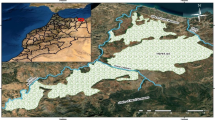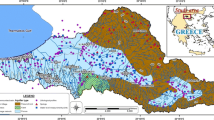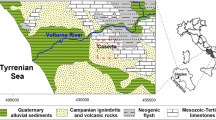Abstract
Groundwater vulnerability and risk mapping is a relatively new scientific approach for facilitating planning and decision making processes in order to protect this valuable resource. Pan European methodology for aquifers vulnerability has recently been developed by assessing all the existing relevant techniques and emphasizing on karstic environments. In the particular study, state-of-the-art methods and tools have been implemented such as remote sensing, isotopic investigations and GIS to map the groundwater vulnerability and pollution risk in a geologically complex area of W. Greece. The updated land use map has been developed from a Landsat 7+TM image elaborated with image analysis software, while the detailed hydrogeologic properties of the area have been recorded with an intensive isotopic study. The local groundwater vulnerability map has been produced following the aforementioned Pan European method, in a GIS environment while the risk map, which was the final product of the study, has been developed after combining the vulnerability and the land use maps. The results indicated that the areas comprised of highly tectonized calcareous formations represented high vulnerability and risk zones while forested areas away from the karstic aquifer illustrated moderate to low vulnerability. Moreover, human activities increase the pollution risk in lowland areas consisting of sedimentary deposits that have been classified as moderate vulnerability. The particular methodology operated efficiently in this study and due to its accuracy and relatively easy implementation can be used as a decision support tool for local authorities.












Similar content being viewed by others
References
Adams B et al (2003) Vulnerability and risk mapping for the protection of carbonate (Karst) aquifers. In: Zwahlen (ed.). Cost action 620, Final report, p 297
Al-Adamat RAN, Foster IDL, Baban SMJ (2003) Groundwater vulnerability and risk mapping for the Basaltic aquifer of the Azraq basin of Jordan using GIS. Remote sensing and DRASTIC. Appl Geogr 23:303–324
Andreo B, Goldscheider N, Vadillo I, María Vías J, Neukum Ch, Sinreich M, Jiménez P, Brechenmacher J, Carrasco F, Hötzl H (2005) Karst groundwater protection: first application of a Pan-European approach to vulnerability, hazard and risk mapping in the Sierra de Líbar (Southern Spain). Sci Total Environ (in press)
Babiker SI, Mohamed MA, Hiyama T, Kato K (2005) A GIS-based DRASTIC model for assessing aquifer vulnerability in Kakamigahara Heights, Gifu Prefecture, central Japan. Sci Total Environ 345:127–140
Diazconti Carreón C, Nelson S, Mayo A, Tingey D, Maren S (2003) A mixed groundwater system at Midway, UT: discriminating superimposed local and regional discharge. J Hydrol 273(1–4):119–138
Dixon B (2005) Groundwater vulnerability mapping: a GIS and fuzzy rule based integrated tool. Appl Geogr 25:327–347
Finch WJ (1997) Estimating direct groundwater recharge using a simple water balance model—sensitivity to land surface parameters. J Hydrol 211:112–125–1998
Fritch TG, McKnight CL, Yelderman JC Jr, Arnold JG (2000) An aquifer vulnerability assessment of the paluxy aquifer, central Texas, USA, using GIS and a modified DRASTIC approach. Environ Manage 25:337–345
Goldscheider N, Klute M, Sturm S, Hotzl H (2000) The PI method: a GIS based approach to mapping groundwater vulnerability with special consideration of karst aquifers. Z Angew Geol 46(3):157–66
Hussain N, Church TM, Kim G (1999) Use of 222-Rn and 226-Ra to trace groundwater discharge into the Chesapeake Bay. Mar Chem 65:127–134
Jeannin Y, Hauns MP, Atteia O (2001) Dispersion, retardation and scale effect in tracer breakthrough curves in karst conduits. J Hydrol 241(3–4, 31):177–193
Jones I, Banner J (2003) Estimating recharge thresholds in tropical karst island aquifers: Barbados, Puerto Rico and Guam. J Hydrol 278(1–4, 25) 131–143
Knox RC, Sabatini DA, Canter LW (1993) Subsurface transport and fate processes. Lewis Publishers, USA
Leontiadis IL, Vergis S, Christodoulou Th (1996) Isotope hydrology study of areas in Eastern Macedonia and Thrace, Northern Greece. J Hydrol 182:1–17
Rundquist DC, Peters AJ, Liping D, Rodekohr DA, Ehrman RL, Murray G (1991) State-wide groundwater vulnerability assessment in Nebraska using the DRASTIC/GIS model. GeoCartogr Int 6:51–58
Swarzenski PW, Reich CD, Spechler RM, Kindinger JL, Moore WS (2001) Using multiple geochemical tracers to characterize the hydrogeology of the submarine spring off Crescent Beach, Florida. Chem Geol 179(1–4):187–202
Vias JM, Andreo B, Perles MJ, Carrasco F, Vadillo I, Jimenez P (2002) Preliminary proposal of a method for vulnerability mapping in carbonate aquifers. In: Carrasco F, Duran JJ, Andreo B (eds) Second Nerja Cave Geol Symp Karst and Environment, 20–23 October 2002, Nerja, Spain, p 75–83
Vrba J, Zoporozec A (1994) Guidebook on mapping groundwater vulnerability. IAH International Contribution for Hydrogeology, vol 16. Hannover7 Heise, p. 131
Zacharias I, Dimitriou E, Koussouris Th (2003) Estimating groundwater discharge into a lake through underwater springs by using GIS technologies. Environ Geol J 44(7):843–851
Acknowledgments
This study was conducted under the Life-Nature 1999 project entitled: ‘Actions for the preservation of Calcareous fens in Trichonis lake’.
Author information
Authors and Affiliations
Corresponding author
Rights and permissions
About this article
Cite this article
Dimitriou, E., Zacharias, I. Groundwater vulnerability and risk mapping in a geologically complex area by using stable isotopes, remote sensing and GIS techniques. Environ Geol 51, 309–323 (2006). https://doi.org/10.1007/s00254-006-0328-8
Received:
Accepted:
Published:
Issue Date:
DOI: https://doi.org/10.1007/s00254-006-0328-8




